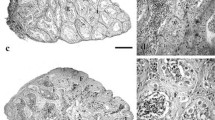Abstract.
It has been a common belief that all puffer fishes are more toxic in their spawning seasons, perhaps to protect their fertilized eggs. However, the current study of two puffer fishes, Takifugu niphobles (Jordan and Snyder) and Takifugu alboplumbeus (Richardson), collected in Hong Kong waters continuously for over a year and bioassayed for toxicity in terms of mouse units (MU), showed the contrary. Their annual spawning seasons (evident from the enlargement of the gonads and the presence of eggs in the ovary) were found to be from October to February (4 consecutive months) and December to February (2 consecutive months), respectively. In both species, the ovaries were highly toxic (100–1,000 MU/g) only in their non-spawning seasons and they became weakly toxic (10–100 MU/g) in their spawning seasons; unlike the ovaries, liver and intestine, the flesh and the skin did not have marked annual toxicity patterns. Their flesh was basically non-toxic (less than 10 MU/g) throughout the whole year. The testes, which were only developed in the spawning seasons, were also found to be non-toxic.
Similar content being viewed by others
Author information
Authors and Affiliations
Additional information
Electronic Publication
Rights and permissions
About this article
Cite this article
Yu, .CF., Yu, .P. Are puffer fish more toxic in their spawning seasons?. Marine Biology 140, 1053–1057 (2002). https://doi.org/10.1007/s00227-001-0774-5
Received:
Accepted:
Issue Date:
DOI: https://doi.org/10.1007/s00227-001-0774-5




